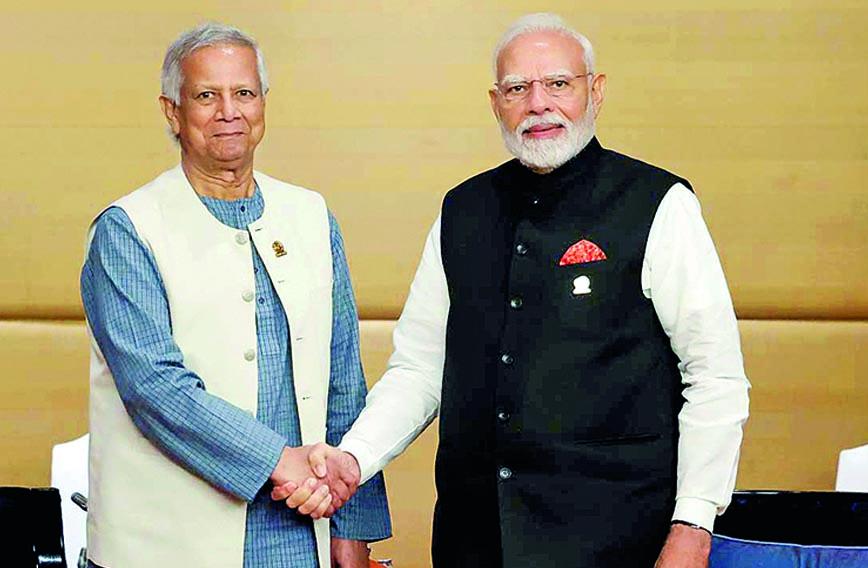
SANJAYA BARU
Most people like to live in a neighbourhood of the similar and the familiar. In India we took it a step too far. In an Agraharam only Brahmins, often of the same sub-caste, would live. Dalits in a village were told where their place was. Moving into urban spaces, people continued to live among people they were familiar with. In my home city of Hyderabad the Maharashtrians from regions that were part of the erstwhile Nizam’s kingdom tended to live in and around Kacheguda. Tamilians, who came with the British-Indian army, lived in Marredpally. When Muslims moved out of the Old City they tended to live among their own in and around Masab Tank.
As the nation’s capital expanded, people arriving from different parts of the country found comfort in living among their own. Punjabi Bagh, naturally, had more Punjabis. Ramakrishnapuram had more South Indians. Bengalis felt more comfortable living among their own in Chittaranjan Park and in Bombay (Mumbai), the Tamils congregated around Chembur. As urbanization spreads new neighbourhoods come up but the effort is always to find neighbourhoods where one can live with the similar and the familiar.
Things have, however, begun to get difficult with communal and caste feelings gaining ascendance. Vegetarians have started banning non-vegetarians from coming in as neighbours in apartment buildings. Hindus do not want Muslim neighbours or tenants. Orthodox families don’t want single men or women and, in some places, live-in partners are a no-no as neighbours. And so, life becomes more complicated.
What happens in our limited neighbourhoods has also happened in our wider sub-continental neighbourhood. Our neighbours have become wary of us just as we have become less tolerant of them. One consequence of this has been that in both trade and tourism our neighbourhood does not count for much. South Asians indulge in less trade and travel with countries within the region than with countries outside. In the past Europe used to be ahead of India as a trade partner for most South Asian countries and with time China has acquired that status. There was a time when India was the biggest trade partner at least for Nepal. No longer. Perhaps Bhutan alone has that status.
While the level of economic and social interaction between neighbours within South Asia remains unimpressive, with time even the political relationship has weakened. Bhutan remains the only neighbour about whom we have no major complaints. Though the Bhutanese may be finding that the newly arriving nouveau riche tourists from India, with money to throw around, loud and noisy, are not exactly the kind of tourists they would like to welcome.
Look around and see that bilateral relations between India and most neighours remains touchy and prickly. Like the many inhabitants of apartment blocks in cities across the country, the present Indian government may also prefer having to deal with fewer Muslims in the neighbourhood! As the saying goes, one can change one’s friends, but one’s got to deal with one’s neighbours. Geography is a given.
A few years ago a senior minister from Singapore gave a lecture in New Delhi under the auspices of the India Foundation, a think tank associated with the Bharatiya Janata Party and headed by the BJP’s general secretary, Ram Madhav. The topic he chose to speak on was how Singapore has tried to deal with the challenge of ethnic and religious pluralism. Its founder leader, Lee Kuan Yew, implemented a policy by which in every apartment block there had to be a mix of Malay, Chinese and Indian origin Singaporeans belonging to different religious faiths — Christianity, Islam, Hinduism and Buddhism.
By forcing people with different ethnic and religious backgrounds, and the consequent differences in cuisine and other social attributes, to live together, Singapore enforced good neighbourliness. It made people learn to live with one another. The Singapore minister’s Delhi audience listened to him politely, but the message has not got across.
Perhaps India requires such a policy that makes every citizen learn to live with others irrespective of caste, religion or region. It is not easy. But there has to be some effort at ending the creeping ghettoization that is happening. People like to live with the like-minded. They prefer to interact with the like-minded. Tolerance levels seem to be going down and good-neighbourliness is disappearing both within the country and within the region.
At the height of the era of optimism in India-Pakistan relations, in the period 2005-07 when Prime Minister Manmohan Singh and President Pervez Musharraf were trying to evolve a workable formula for peace in the sub-continent and a final resolution of the Kashmir issue, Dr Singh spoke of a future in which one could think of “having breakfast in Amritsar, lunch in Lahore and dinner in Kabul”. How far we have travelled since then.
Today one would be laughed out of court for having such a vision for the region. Dr Singh had also famously said that borders are but lines on a map. Today, borders are being defined by barbed wires and concrete walls. People visiting relatives across political borders have been asked to go back.
Diplomats talk of a ‘neighbourhood policy’. If we are not clear who our neighbour is, what policy can we have towards one? Many Indians seem happier embracing distant neighbours with whom one does not have much in common and find dealing with immediate neighbours more difficult. In fact, despite all the official rhetoric about a neighbourhood policy India has none. It has no way of dealing with both threats and opportunities in its immediate South Asian neighbourhood, even as it reaches out to distant neighbours in Southeast Asia and West Asia.
Sanjaya Baru is a writer and Distinguished Fellow at the United Service Institution of India
Comments
-

Mohammed Abdur Raheem - May 29, 2025, 7:06 a.m.
The writeup on Living with neighbors is most outstanding as today the whole world is getting divided on various segments not only in India or Asian Subcontinent but all over the world except for few who are not on those lines. But the tendency is to live in a neighborhood exclusively for an ethenic group is catching up and dividing the humanity in small and untolerable groups. It will be a challenging task for future generations to coexist. Sanjay it is a very timely writeup. Keep the pen mould this society
-

Porus Dadabhoy - May 27, 2025, 11:42 p.m.
In the Usa we call it today polarization earlier it was segregation today in the usa braver Angels and and United for Peace work on this as does interfaith meetings such as the Parliament of world religions
-

Saurabh Singh - May 27, 2025, 5:53 p.m.
Worked in Bangladesh for long. Traveled dozen of times. There are fundamentalists everywhere. In universities, colleges, offices everywhere. The other notable group is who want to go abroad. Many of them do leave their homeland and settle abroad every year. I didn't see other feelings in people of Bangladesh. The investment in Bangladesh is via ngo sector or army. Sheikh Hasina tried to change the course and brought investments from the west fiis, companies etc. and reform democracy in Bangladesh. But fundamentalists, army and MD Yunus opposed her. MD and fundamentalists are one in Bangladesh. There may be other issues as well. But this is what I see and feel about Bangladesh. Most beautiful, lush and green country. Have been visiting it since 2009 regularly. Last I was there in 2023. Next two years will be very interesting. Rangpur upwards, the northern part especially.
-

Rahul Choudhuri - May 27, 2025, 5:39 p.m.
Apropos of Sanjaya Baru’s article, “ Living with Neighbours” the reasons for India’s poor relations with its immediate neighbours lie in two events immediately following independence viz. British perfidy in the form of a pro Pakistan tilt with reference to Kashmir and India’s desire to carry on the imperial ambitions of its former masters in Tibet. While Mountbatten’s appointment as Governor General can be justified as a necessary precondition for the transfer of power, the appointment of British officers as Commander in Chief of independent India’s army can only be explained as incredible naïveté on the part of Nehru and his cabinet. Even after Rob Lockhart was sacked by Nehru, he was replaced by another British Officer Roy Bucher. The lukewarm manner in which the two of them conducted the first Kashmir War resulted in things reaching a stalemate when Cariappa took over in 1949 and India accepted the UN sponsored cease fire. With Pakistan now a nuclear power, POK together with Gilgit Baltistan will never be recovered unless the country itself breaks up. Regarding Tibet,India never gave any importance to the Chinese Central Government’s persistent refusal to accept the British inspired nineteenth century Johnson Line as well as the McMahon Line as the boundaries between the two countries. All through the fifties Chou en Lai proposed that China retain Aksai Chin in Ladakh while India retained NEFA ( now Arunachal Pradesh). Ultimately China settled matters in 1962 through the use of force, though India’s ill advised “Forward Policy” shared much of the blame. There is no point blaming recent developments for problems with neighbours. Events that took place three quarters of a century ago cannot be wished away.




